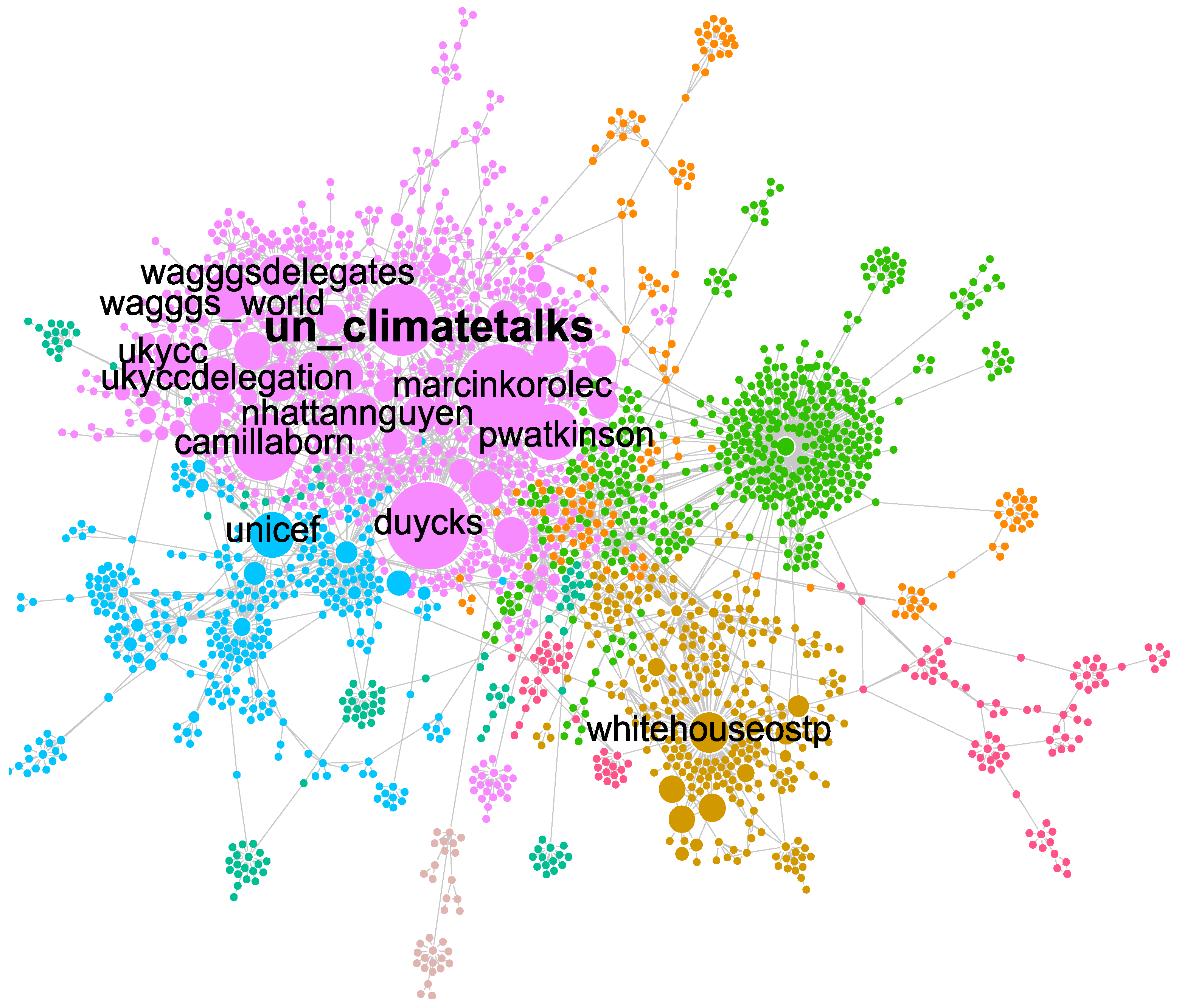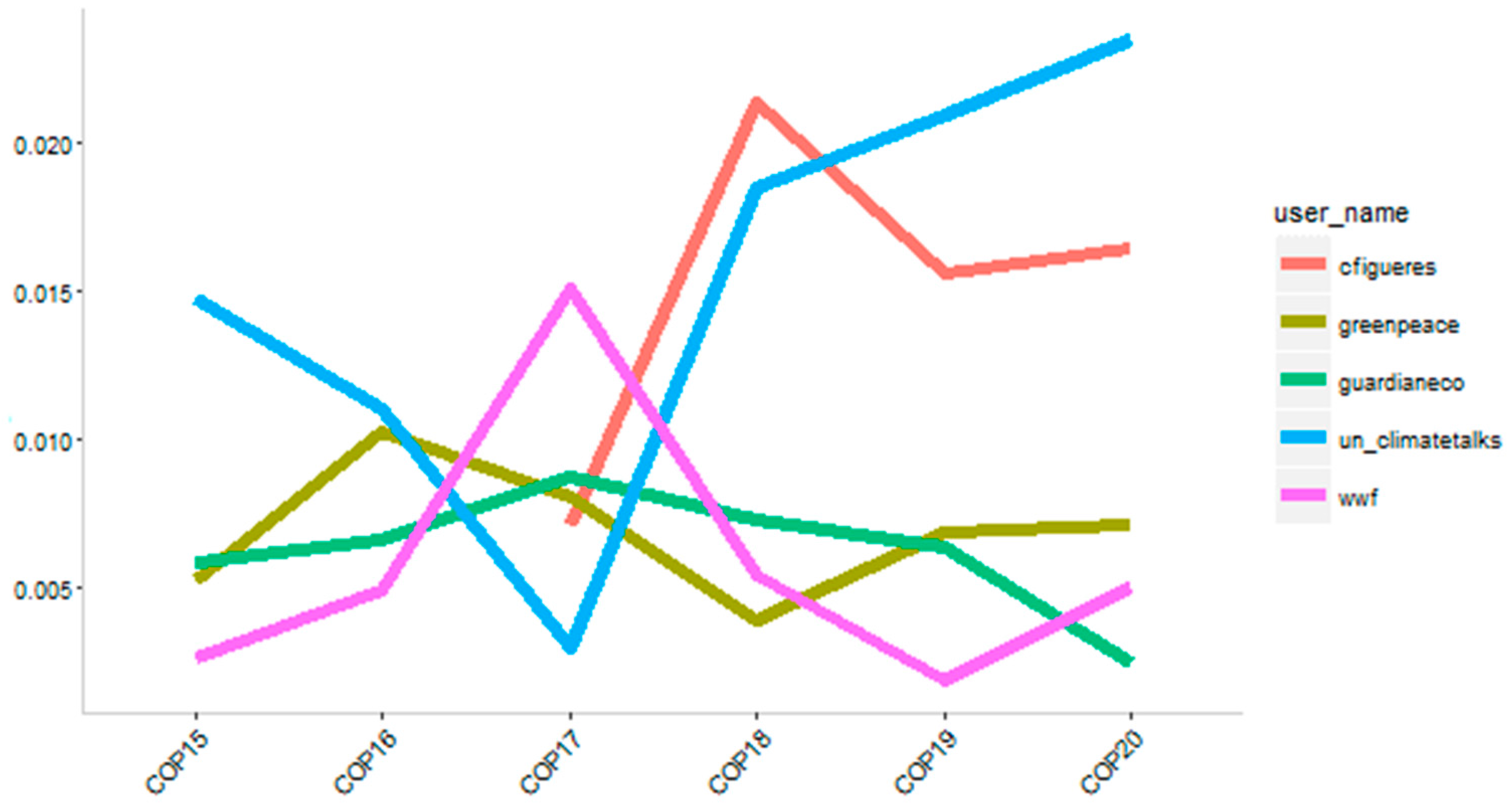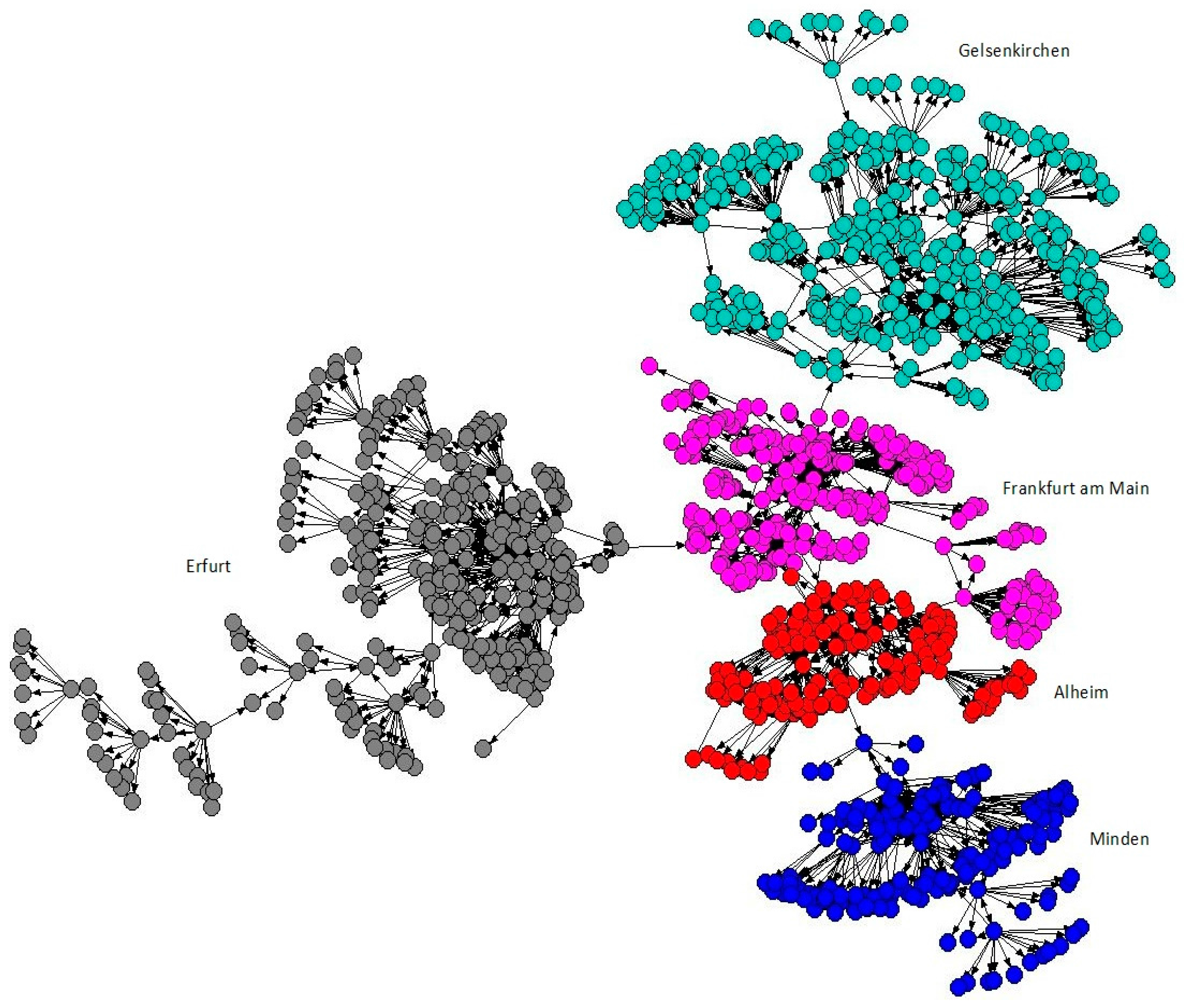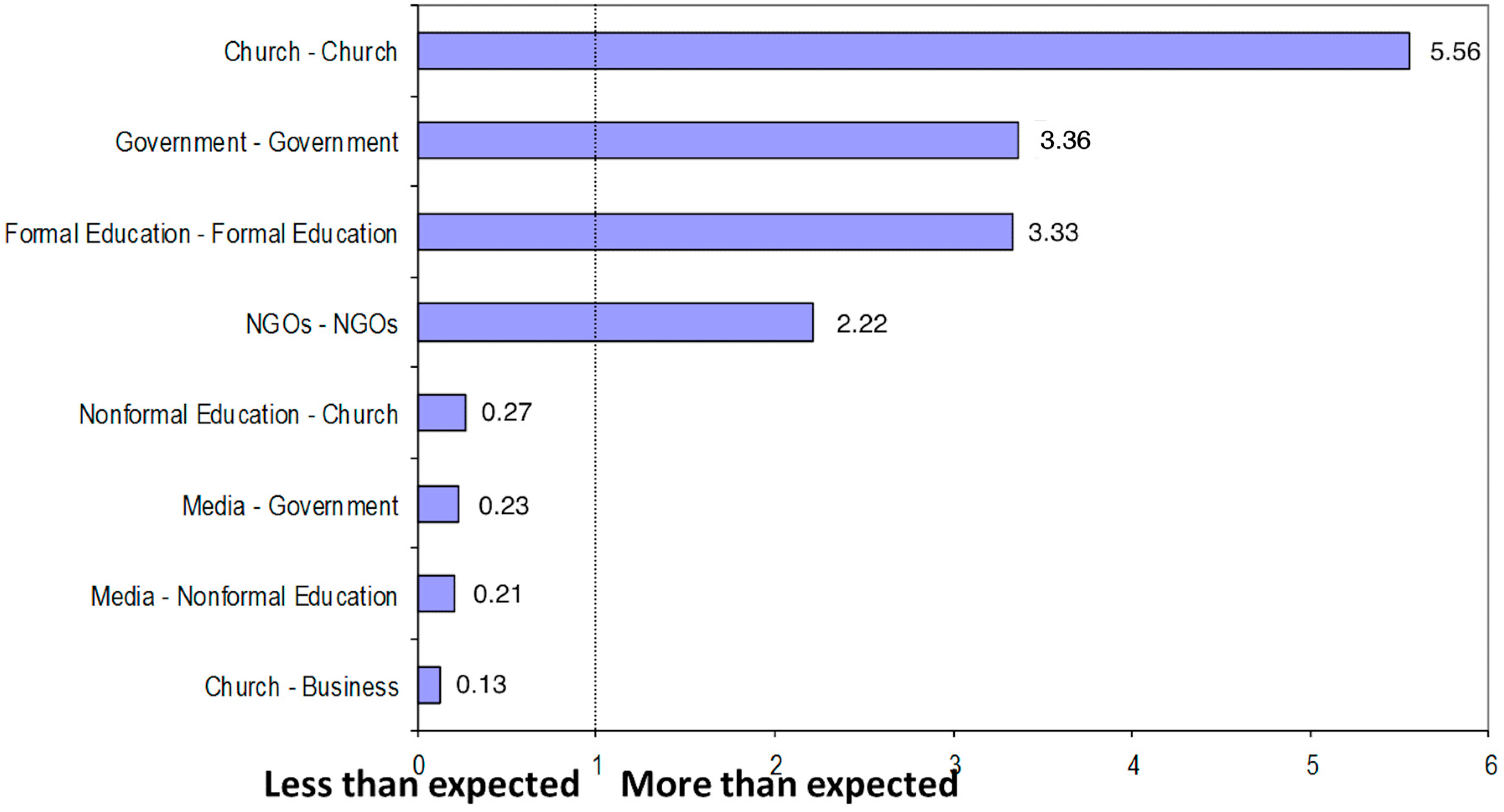Levels of Governance in Policy Innovation Cycles in Community Education: The Cases of Education for Sustainable Development and Climate Change Education
Abstract
:1. Introduction
2. State of the Art
2.1. Climate Change Education
2.2. Education for Sustainable Development (This Section Summarizes the Main Findings of [9])
3. Theoretical and Methodological Orientation
3.1. Theoretical Orientation
3.2. Measuring Influence in Complex Multi-Actor and Multi-Level Policy Settings
3.3. SNA as a Tool for Studying CCE and ESD
4. Results
4.1. Social Network Analysis in Climate Change Education (This Section Summarizes the Main Findings of [1])
4.2. Social Network Analysis of Education for Sustainable Development (This Section Summarizes the Main Findings of [9])
5. Discussion
Acknowledgments
Author Contributions
Conflicts of Interest
Funding
References
- Kolleck, N.; Well, M.; Sperzel, S.; Jörgens, H. Climate Change Education through Social Networks: How a Treaty Secretariat Creates Momentum for Education in the UNFCCC. Glob. Environ. Politics 2017, in press. [Google Scholar] [CrossRef]
- Song, M.; Miskel, C.G. Exploring the Structural Properties of the State Reading Policy Domain Using Network Visualization Technique. Educ. Policy 2007, 21, 589–614. [Google Scholar] [CrossRef]
- White, H. Identity and Control: How Social Formations Emerge; Princeton University Press: Princeton, NJ, USA, 2008. [Google Scholar]
- Tilbury, D.; Wortman, D. How is Community Education Contributing to Sustainability in Practice? Appl. Environ. Educ. Commun. 2008, 7, 83–93. [Google Scholar] [CrossRef]
- Kagawa, F.; Selby, D. Education and Climate Change: Living and Learning in Interesting Times; Routledge: New York, NY, USA, 2010. [Google Scholar]
- United Nations Educational, Scientific and Cultural Organization (UNESCO). Not Just Hot Air, Putting Climate Change Education into Practice. 2015. Available online: http://www.uncclearn.org/sites/default/files/inventory/unesco01_0.pdf (accessed on 22 March 2017).
- United Nations Framework Convention on Climate Change (UNFCCC). FCCC/INFORMAL/84 United Nations Framework Convention on Climate Change; UNFCCC: Bonn, Germany, 1992. [Google Scholar]
- United Nations Framework Convention on Climate Change (UNFCCC). Paris Agreement; UNFCCC: Bonn, Germany, 2015. [Google Scholar]
- Kolleck, N. Uncovering influence through Social Network Analysis: The role of schools in Education for Sustainable Development. J. Educ. Policy 2016, 31, 308–329. [Google Scholar] [CrossRef]
- Kolleck, N. Innovationen und Bildungslandschaften: Ergebnisse Sozialer Netzwerkanalysen. In Auf dem Weg zu Nachhaltigen Bildungslandschaften. Lokale Netzwerke Erforschen Und Gestalten; Fischbach, R., Kolleck, N., de Haan, G., Eds.; VS/Springer Verlag: Wiesbaden, Germany, 2015; pp. 55–68. [Google Scholar]
- Kolleck, N.; Bormann, I. Analyzing trust in innovation networks: Combining quantitative and qualitative techniques of Social Network Analysis. Zeitschrift für Erziehungswissenschaft 2014, 17, 9–27. [Google Scholar] [CrossRef]
- Kolleck, N.; Bormann, I.; Höhne, T. Zum Innovations- und Bildungsverständnis von Stiftungen. Zeitschrift für Pädagogik 2015, 61, 793–807. [Google Scholar]
- Springett, D. Education for Sustainable Development. In Routledge International Handbook of Sustainable Development; Redclift, M.R., Springett, D., Eds.; Routledge: London, UK, 2015; pp. 105–119. [Google Scholar]
- Boeve-de Pauw, J.; Gericke, N.; Olsson, D.; Berglund, T. The Effectiveness of Education for Sustainable Development. Sustainability 2015, 7, 15693–15717. [Google Scholar] [CrossRef]
- De Haan, G.; Bormann, I.; Leicht, A. Introduction: The midway point of the UN Decade of Education for Sustainable Development: Current research and practice in ESD. Int. Rev. Educ. 2010, 56, 199–206. [Google Scholar] [CrossRef]
- Evans, N.; Whitehouse, H.; Gooch, M. Barriers, Successes and Enabling Practices of Education for Sustainability in Far North Queensland Schools: A Case Study. J. Environ. Educ. 2012, 43, 121–138. [Google Scholar] [CrossRef]
- Gourevitch, P. The Second Image Reversed: The International Sources of Domestic Politics. Int. Org. 1978, 32, 881–912. [Google Scholar] [CrossRef]
- Jörgens, H. Governance by Diffusion: Implementing Global Norms through Cross-National Imitation and Learning. In Governance for Sustainable Development: The Challenge of Adapting Form to Function; Lafferty, W.M., Ed.; Edward Elgar: Cheltenham, UK, 2004; pp. 246–283. [Google Scholar]
- Risse, T.; Ropp, S.C.; Sikkink, K. The Persistent Power of Human Rights: From Commitment to Compliance; Cambridge University Press: Cambridge, UK, 2013. [Google Scholar]
- Madsen, K. Unfolding Education for Sustainable Development as Didactic Thinking and Practice. Sustainability 2013, 5, 3771–3782. [Google Scholar] [CrossRef]
- Cebrián, G.; Junyent, M. Competencies in Education for Sustainable Development: Exploring the Student Teachers’ Views. Sustainability 2015, 7, 2768–2786. [Google Scholar] [CrossRef]
- Uherek, E.; Schüpbach, E. European Efforts in Earth Science and Climate Change Education. Phys. Geogr. 2008, 29, 545–560. [Google Scholar] [CrossRef]
- Sarabhai, K.V.; Ravindranath, S.; Schwarz, R.; Vyas, P. ESD and the Rio Conventions. J. Educ. Sustain. Dev. 2012, 6, 181–190. [Google Scholar] [CrossRef]
- Fulge, T.; Bieber, T.; Martens, K. Rational Intentions and Unintended Consequences: On the Interplay between International and National Actors in Education Policy. In The Handbook of Global Education Policy; Mundy, K.E., Green, A., Lingard, B., Verger, A., Eds.; John Wiley & Sons: Malden, MA, USA, 2016; pp. 453–469. [Google Scholar]
- Dingwerth, K.; Jörgens, H. Environmental Risks and the Changing Interface of Domestic and International Governance. In The Oxford Handbook on Transformation of the State; Leibfried, S., Nullmeier, F., Huber, E., Lange, M., Levy, J., Stephens, J., Eds.; Oxford University Press: Oxford, UK, 2015; pp. 338–354. [Google Scholar]
- Jansen, D.; Wald, A. Netzwerktheorien. In Handbuch Governance: Theoretische Grundlagen und empirische Anwendungsfelder; Benz, A., Lütz, S., Schimank, U., Simonis, G., Eds.; VS Verlag für Sozialwissenschaften: Wiesbaden, Germany, 2007; pp. 188–199. [Google Scholar]
- Borgatti, S.P.; Lopez-Kidwell, V. Network Theory. In The SAGE Handbook of Social Network Analysis; Scott, J., Carrington, P.J., Eds.; Sage: London, UK, 2011; pp. 40–54. [Google Scholar]
- Granovetter, M.S. The Strength of Weak Ties. Am. J. Sociol. 1973, 78, 1360–1380. [Google Scholar] [CrossRef]
- Burt, R.S. Toward a Structural Theory of Action: Network Models of Social Structure, Perception, and Action; Academic Press: New York, NY, USA, 1982. [Google Scholar]
- Coleman, J.S. Social capital in the creation of human capital. Am. J. Sociol. 1988, 94, 95–120. [Google Scholar] [CrossRef]
- Verweij, S.; Klijn, E.-H.; Edelenbos, J.; van Buuren, A. What makes governance networks work? A Fuzzy set qualitative comparative analysis of 14 Dutch spatial planning projects. Public Adm. 2013, 91, 1035–1055. [Google Scholar] [CrossRef]
- Ward, M.D.; Stovel, K.; Sacks, A. Network Analysis and Political Science. Ann. Rev. Political Sci. 2011, 14, 245–264. [Google Scholar] [CrossRef]
- Dür, A. Interest groups in the European Union: How powerful are they? West Eur. Politics 2008, 31, 1212–1230. [Google Scholar] [CrossRef]
- Ingold, K.; Leifeld, P. Structural and Institutional Determinants of Influence Reputation: A Comparison of Collaborative and Adversarial Policy Networks in Decision Making and Implementation. J. Public Adm. Res. Theory 2016, 26, 1. [Google Scholar] [CrossRef]
- Lecy, J.D.; Mergel, I.A.; Schmitz, H.P. Networks in Public Administration: Current Scholarship in Review. Public Manag. Rev. 2014, 16, 643–665. [Google Scholar] [CrossRef]
- Rode, H.; Michelsen, G. Der Beitrag der UN-Dekade 2005–2014 zur Verbreitung und Verankerung der Bildung für nachhaltige Entwicklung; Deutsche UNESCO-Kommission e.V. (DUK): Bonn, Germany, 2012. [Google Scholar]
- Ye, K.; Liu, G.; Shan, Y. Networked or Un-Networked? A Preliminary Study on KIBS-Based Sustainable Urban Development: The Case of China. Sustainability 2016, 8, 509. [Google Scholar] [CrossRef]
- Bodin, Ö.; Crona, B.I. The role of social networks in natural resource governance: What relational patterns make a difference? Glob. Environ. Chang. 2009, 19, 366–374. [Google Scholar] [CrossRef]
- Lubell, M.; Schneider, M.; Scholz, J.T.; Mete, M. Watershed Partnerships and the Emergence of Collective Action Institutions. Am. J. Political Sci. 2002, 46, 148–163. [Google Scholar] [CrossRef]
- Slaughter, A.-M. The Chessboard and the Web: Strategies of Connection in a Networked World; Yale University Press: New Haven, CT, USA, 2017. [Google Scholar]
- Kwak, H.; Lee, C.; Park, H.; Moon, S. What is Twitter, a social network or a news media? In Proceedings of the 19th International Conference on World Wide Web, Raleigh, NC, USA, 26–30 April 2010; pp. 591–600. [Google Scholar]
- Wasserman, S.; Faust, K. Social Network Analysis: Methods and Applications, 19th ed.; Cambridge Univ. Press: Cambridge, UK, 2009. [Google Scholar]
- Scott, J. Social Network Analysis: A Handbook; Sage: Los Angeles, CA, USA, 2007. [Google Scholar]
- Fischer, C. To Dwell among Friends: Personal Networks in Town and City; The University of Chicago Press: Chicago, IL, USA, 1982. [Google Scholar]
- Kowald, M.; Axhausen, K.W. Focusing on Connected Personal Leisure Networks: Selected Results from a Snowball Sample. Environ. Plan. 2012, 44, 1085–1100. [Google Scholar] [CrossRef]
- Leontief, W. The Structure of American Economy, 1919–1929: An Empirical Application of Equilibrium Analysis; Harvard University Press: Cambridge, MA, USA, 1941. [Google Scholar]
- Seeley, J.R. The net of reciprocal influence; a problem in treating sociometric data. Can. J. Psychol. Rev. Can. Psychol. 1949, 3, 234–240. [Google Scholar] [CrossRef]
- Mejova, Y.; Weber, I.; Macy, M. Twitter: A Digital Socioscope; Cambridge University Press: New York, NY, USA, 2015. [Google Scholar]
- Blondel, V.; Guillaume, J.-L.; Lambiotte, R.; Lefebvre, E. Fast Unfolding of Communities in Large Networks. J. Stat. Mech. Theory Exp. 2008, 2008. [Google Scholar] [CrossRef]
- Dekker, D.; Krackhardt, D.; Snijders, T.A.B. Sensitivity of MRQAP Tests to Collinearity and Autocorrelation Conditions. Psychometrika 2007, 72, 563–581. [Google Scholar] [CrossRef] [PubMed] [Green Version]
- Kolleck, N. Innovations through networks: Understanding the role of social relations for educational innovations. Zeitschrift für Erziehungswissenschaft 2014, 17, 47–64. [Google Scholar] [CrossRef]
- Shiroma, E.O. Networks in action: New actors and practices in education policy in Brazil. J. Educ. Policy 2014, 29, 323–348. [Google Scholar] [CrossRef]
- Valente, T.W. Network Models and Methods for Studying the Diffusion of Innovations. In Models and Methods in Social Network Analysis; Carrington, P.J., Scott, J., Wasserman, S., Eds.; Cambridge Univ. Press: Cambridge, UK, 2005; pp. 98–116. [Google Scholar]






© 2017 by the authors. Licensee MDPI, Basel, Switzerland. This article is an open access article distributed under the terms and conditions of the Creative Commons Attribution (CC BY) license (http://creativecommons.org/licenses/by/4.0/).
Share and Cite
Kolleck, N.; Jörgens, H.; Well, M. Levels of Governance in Policy Innovation Cycles in Community Education: The Cases of Education for Sustainable Development and Climate Change Education. Sustainability 2017, 9, 1966. https://doi.org/10.3390/su9111966
Kolleck N, Jörgens H, Well M. Levels of Governance in Policy Innovation Cycles in Community Education: The Cases of Education for Sustainable Development and Climate Change Education. Sustainability. 2017; 9(11):1966. https://doi.org/10.3390/su9111966
Chicago/Turabian StyleKolleck, Nina, Helge Jörgens, and Mareike Well. 2017. "Levels of Governance in Policy Innovation Cycles in Community Education: The Cases of Education for Sustainable Development and Climate Change Education" Sustainability 9, no. 11: 1966. https://doi.org/10.3390/su9111966




